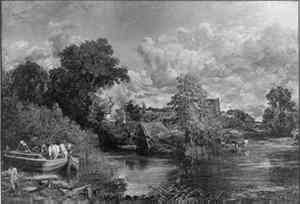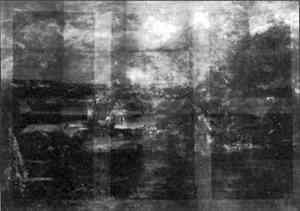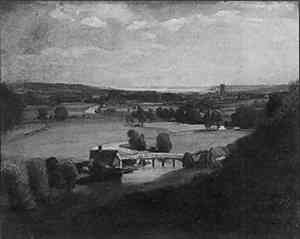INTERPRETING ARTIST'S INTENT IN THE TREATMENT OF JOHN CONSTABLE'S THE WHITE HORSE SKETCHMICHAEL SWICKLIK
2 BACKGROUNDJohn Constable, with J. M. W. Turner among the pre-eminent British landscape painters of the 19th century, was still relatively unknown around 1818–19 when he began painting the National Gallery of Art's version of The White Horse. He painted another version of this painting (of similar scale, approximately 4 � 6 ft) for the Royal Academy exhibition of 1819 (fig. 2, p. 364). This version, dated 1819 and now in the Frick Collection, received critical acclaim and led to Constable's election to associate membership in the Royal Academy.
Although the history of the Frick painting was well documented, the version in the National Gallery of Art had a less certain provenance. It was not recorded in the Constable literature until it appeared in a catalog for the 1872 exhibition at the Royal Academy, which lists it as “118, The White Horse, John Constable, R. A., Canvas, 49 � 70 1/2 in. Lent by John Pender Esq.” It was next recorded as exhibited in 1882 in E. Fox White's gallery in London. The following year a full-page reproduction engraving by O. Jahyer was included as part of an article on Constable in the Magazine of Art (fig. 3, p. 364). In 1893 the picture was purchased from Wallis and Son, London by Peter A. B. Widener. In 1942, his son, Joseph E. Widener, donated it in his memory to the National Gallery of Art (Rhyne 1990).
Although The White Horse was given a prominent position in the galleries upon donation, its appearance, which was somewhat atypical for Constable, gave reason for some discussion. Writing about the painting in 1944, John Walker, then director of the National Gallery, said, “It seems to me a full size sketch
Many issues remained unresolved when conservation treatment was first considered in 1992, including whether the visible composition had been meant as a finished version or as a sketch of The White Horse. If it were a sketch, what could explain its current appearance? Even taking the distortion of the thick, highly discolored varnish into consideration, the painting did not present the visual characteristics of a Constable sketch. The painting was heavy and cumbersome, rather than loose and lively; the paint itself was transparent and liquid, not opaque and thick; the trees were rendered as massive, filled-in, hard-edged shapes, not as Constable's typically brushy, air-filled, irregular forms. In many respects the painting was more like a finished work than a sketch. If heavy repainting explained this look, why had this occurred, and who did it? From the engraving by O. Jahyer in 1883 it was clear that any overpainting would have been in place by that date. Given repainting as an explanation for the painting's appearance, it was not immediately clear whether it had been done by a different person to turn a less |



